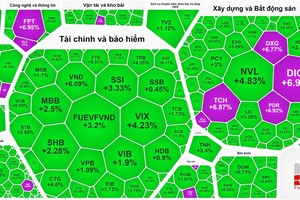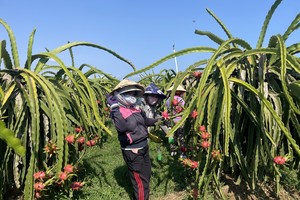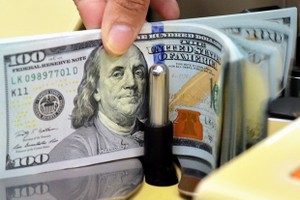
Therefore, since the beginning of this year, in their market strategies, many enterprises have been more flexible and diverse, avoiding dependence on only some traditional markets as currently.
So far, Vietnamese products have been exported to nearly 200 countries in the world. Of which, there are 50 traditional markets with the export growth maintained at a two-digit number. According to an analysis by economic experts, export activities will boom for enterprises, which already have a solid foundation in production activity, this year.
Mr. Vu Duc Giang, Chairman of the Vietnam Apparel and Textile Association, said that although standards and trade barriers at export markets change every year, they are still based on certain basic foundation, thus, with enterprises which already have experience in exporting goods, especially to choosy markets, those barriers are no longer worrying. The matter is that for enterprises that are new to export markets or have investment strategies for exporting, instead of complaining and passively waiting for the support of relevant authorities, they should actively study more about product quality standards of markets that they want to access, thereby, improving production process accordingly.
In fact, the standards on product quality, trade and technical barriers are always publicized by importing countries on the information network; enterprises only need to study to evaluate whether their internal production capacity is suitable or not, or what they need to improve.
Regarding this matter, the representative of Nutifood said that to be able to export Vietnamese dairy products to the US market, his company had to invest in a new production line. Accordingly, the product must be strictly controlled, combined with traceability from the stage of input materials to the stage of finished products, transporting and distributing to consumers.
From another perspective, Vinamilk said that input material greatly affects the quality of the product, as well as the level of market reception. From its experience when exporting dairy products to Chinese and Singaporean markets, it showed that to have a quality safe source of milk that meets the requirements of importing countries, the company invested in a dairy farm that meets organic standards of Europe. This not only helps the company to have a stable source of materials but also helps it to take advantage of the preferential export tax, especially safely passes the technical barriers of the markets.
The export market is said to have many highlights this year. Currently, domestic enterprises have been making the most out of the preferential tariffs in order to increase market share at markets that Vietnam has already signed free trade agreements (FTAs), including Japan, South Korea, Australia, New Zealand, and the ASEAN.
The Comprehensive and Progressive Agreement for Trans-Pacific Partnership has also been studied by many enterprises to raise export market share. This market is considered a potential market with a population scale of 600 million people.
Despite being a traditional market, the EU market is the market with the highest expectation this year as Vietnam and the EU have finished the signing of the FTA. The representative of the Vietnam Leather, Footwear and Handbag Association said that the EU-Vietnam Free Trade Agreement is still waiting for the approval of the EU Parliament, when it becomes effective, the EU will remove around 85.6 percent of import tax lines, or 70.3 percent of Vietnam’s export turnover to the EU. After seven years, 99.2 percent of tax lines will reduce to zero percent or 99.7 percent of Vietnam’s export turnover. The products that benefit most include textiles, footwear. aquatic products (except canned tuna and fish balls), and rice.
Obviously, to make use of the advantages brought by FTAs, besides efforts of authorities in removing trade barriers and effectively preventing origin fraud, enterprises should also actively upgrade production technology. Especially, they should not join hands with enterprises that engage in origin fraud, harming export activities when other countries launch investigations and apply trade remedies. In addition, enterprises should invest in high value-added products, thereby helping Vietnamese products to gain a higher position in the global market.
The product lines with export turnover above $1 billion last year are forecast to make a strong breakthrough this year, mainly focusing on cell phones and components, electronics, computers and components, machinery, equipment, wood and wooden products. The latest survey by the General Statistics Office of Vietnam showed that, in the first six months of this year, 91.5 percent of enterprises are forecast to have the number of export orders increased and stabilized and 8.5 percent of enterprises are forecast to see a decline in the number of export orders.
So far, Vietnamese products have been exported to nearly 200 countries in the world. Of which, there are 50 traditional markets with the export growth maintained at a two-digit number. According to an analysis by economic experts, export activities will boom for enterprises, which already have a solid foundation in production activity, this year.
Mr. Vu Duc Giang, Chairman of the Vietnam Apparel and Textile Association, said that although standards and trade barriers at export markets change every year, they are still based on certain basic foundation, thus, with enterprises which already have experience in exporting goods, especially to choosy markets, those barriers are no longer worrying. The matter is that for enterprises that are new to export markets or have investment strategies for exporting, instead of complaining and passively waiting for the support of relevant authorities, they should actively study more about product quality standards of markets that they want to access, thereby, improving production process accordingly.
In fact, the standards on product quality, trade and technical barriers are always publicized by importing countries on the information network; enterprises only need to study to evaluate whether their internal production capacity is suitable or not, or what they need to improve.
Regarding this matter, the representative of Nutifood said that to be able to export Vietnamese dairy products to the US market, his company had to invest in a new production line. Accordingly, the product must be strictly controlled, combined with traceability from the stage of input materials to the stage of finished products, transporting and distributing to consumers.
From another perspective, Vinamilk said that input material greatly affects the quality of the product, as well as the level of market reception. From its experience when exporting dairy products to Chinese and Singaporean markets, it showed that to have a quality safe source of milk that meets the requirements of importing countries, the company invested in a dairy farm that meets organic standards of Europe. This not only helps the company to have a stable source of materials but also helps it to take advantage of the preferential export tax, especially safely passes the technical barriers of the markets.
The export market is said to have many highlights this year. Currently, domestic enterprises have been making the most out of the preferential tariffs in order to increase market share at markets that Vietnam has already signed free trade agreements (FTAs), including Japan, South Korea, Australia, New Zealand, and the ASEAN.
The Comprehensive and Progressive Agreement for Trans-Pacific Partnership has also been studied by many enterprises to raise export market share. This market is considered a potential market with a population scale of 600 million people.
Despite being a traditional market, the EU market is the market with the highest expectation this year as Vietnam and the EU have finished the signing of the FTA. The representative of the Vietnam Leather, Footwear and Handbag Association said that the EU-Vietnam Free Trade Agreement is still waiting for the approval of the EU Parliament, when it becomes effective, the EU will remove around 85.6 percent of import tax lines, or 70.3 percent of Vietnam’s export turnover to the EU. After seven years, 99.2 percent of tax lines will reduce to zero percent or 99.7 percent of Vietnam’s export turnover. The products that benefit most include textiles, footwear. aquatic products (except canned tuna and fish balls), and rice.
Obviously, to make use of the advantages brought by FTAs, besides efforts of authorities in removing trade barriers and effectively preventing origin fraud, enterprises should also actively upgrade production technology. Especially, they should not join hands with enterprises that engage in origin fraud, harming export activities when other countries launch investigations and apply trade remedies. In addition, enterprises should invest in high value-added products, thereby helping Vietnamese products to gain a higher position in the global market.
The product lines with export turnover above $1 billion last year are forecast to make a strong breakthrough this year, mainly focusing on cell phones and components, electronics, computers and components, machinery, equipment, wood and wooden products. The latest survey by the General Statistics Office of Vietnam showed that, in the first six months of this year, 91.5 percent of enterprises are forecast to have the number of export orders increased and stabilized and 8.5 percent of enterprises are forecast to see a decline in the number of export orders.
























